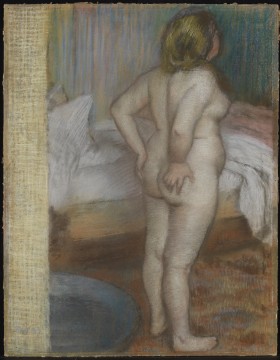The Morning Bath
Provenance
Josse (1870–1941) and Gaston (1870–1953) Bernheim-Jeune, Paris, by 1914. Mrs. C. Matthyssen, Paris; [sold as a share to Galerie Durand-Ruel and Galerie Bernheim-Jeune, Paris, 26 March 1921]; [full share sold to Galerie Bernheim-Jeune, Paris, 13 Mar. 1922]. Sold at auction, Hotel Drouot, Paris, Tableaux modernes…provenant de la collection "L'art moderne" [Lucerne], 20 June 1935, no. 7; bought by M. Clerc. [Possibly with Galerie Bernheim-Jeune, Paris]. David-Weill collection, Paris, by 1947. [Galerie Krugier et Cie, Geneva]. Henry Pearlman, by 1966; Henry and Rose Pearlman Foundation, after 1974.
Critical Perspective
Degas was drawn to the pastel medium because it provides both rich color and spontaneous line in the same stroke and can be worked and re-worked to create complex textures. Here, the viewer’s glimpse of a bather awash in the soft morning light suggests an immediacy that appealed to Degas, who wanted to capture the transitory quality of modern life.
When he displayed this pastel along with others of women bathing and drying themselves at the final Impressionist exhibition, in 1886, its uncompromising realism provoked a tirade of negative criticism, resulting in the popular subtitle "la boulangère" (the baker's wife), deriding the model’s unfashionably plump figure.

